Lakhmir Singh Physics Class 10 Solutions Sources Of Energy
Lakhmir Singh Physics Class 10 Solutions Sources Of Energy
Lakhmir Singh Physics Class 10 Solutions Page No:121
Question 1:
Name a non-renewable source of energy other than fossil fuels.
Solution :
Nuclear fuels (like uranium)
Question 2:
Define calorific value of a fuel.
Solution :
The amount of heat produced by burning 1 gram of a fuel completely is known as its calorific value.
Question 3:
“The calorific value of cooking gas (LPG) is 50 kj/g”. What does it mean ?
Solution :
Calorific value of LPG is 50kJ/gm means that if 1 gram of LPG is burnt completely, then it will produce 50kJ of heat energy.
Question 4:
Which of the following produces more heat (per unit mass) on burning ?
Coal or LPG
Solution :
LPG, due to its higher calorific value.
Lakhmir Singh Physics Class 10 Solutions Page No:122
Question 5:
Define ignition temperature of a fuel.
Solution :
Ignition temperature of fuel can be defined as the minimum temperature to which a fuel must be heated so that it may catch fire and start burning.
Question 6:
“The ignition temperature of a fuel is 80°C”. What does this mean ?
Solution :
If ignition temp of a fuel is 80oC, this means that minimum 80oC is required for the ignition of the fuel.
Question 7:
Fill in the following blank with a suitable word :
The amount of heat produced by burning a unit mass of a fuel completely is known as its………………… value.
Solution :
calorific.
Question 8:
What is a source of energy ? What are the two main categories of the sources of energy ?
Solution :
A source of energy is one which can provide adequate amount of energy in a convenient form over a long period of time.
Two main categories of the source of energy are:
i. Renewable source of energy
ii. Non- renewable source of energy
Question 9:
State any four characteristics of a good source of energy.
Solution :
A good source of energy is one:
(i) which would do a large amount of work per unit mass,
(ii) which is cheap and easily available,
(iii) which is easy to store and transport,
(iv) which is safe to handle and use.
Question 10:
What is meant by a non-renewable source of energy ? Give two examples of non-renewable sources of energy.
Solution :
A non-renewable source of energy is defined as the source of energy which has accumulated in nature over a very, very long time and cannot be quickly replaced when exhausted.
Ex. Coal, petroleum etc.
Question 11:
What is meant by a renewable source of energy ? Give two examples of renewable sources of energy.
Solution :
A renewable source of energy is the one which is being produced continuously in nature and is inexhaustible.
Ex. wind energy, ocean thermal energy etc.
Question 12:
What is the difference between a renewable and a non-renewable source of energy ? Explain with examples.
Solution :
Renewable source of energy can be used again and again endlessly, where as non-renewable source of energy cannot be renewed once used.
Ex. Renewable sources of energy are wind energy, ocean energy.
Non-renewable sources of energy are coal, fossil fuel.
Question 13:
Why are fossil fuels classified as non-renewable sources of energy ?
Solution :
Fossil fuels are known as non-renewable sources of energy because fossil fuels once used cannot renewed or regained.
Question 14:
Name two sources of energy that you think are renewable. Give reason for your choice.
Solution :
Air and water, because both air and water can be used again and again endlessly, they never get exhausted.
Question 15:
Name two sources of energy which you consider to be non-renewable. Give reason for your choice.
Solution :
Petroleum and coal are non-renewable sources of energy because they cannot be used again once exhausted.
Question 16:
(a) Classify the following into renewable and non-renewable sources of energy :
Coal, Wind, Tides, Petroleum, Wood, Natural gas
(b) What is the basis of above classification ?
Solution :
(a) Renewable source of energy – wind, tides, wood
Non- Renewable source of energy – coal, petroleum, natural gas
(b) The above classification is based on the fact that renewable sources are inexhaustible, whereas non-renewable sources are exhaustible.
Question 17:
Coal is said to be formed from the wood of trees. Why then is coal considered to be a non-renewable source of energy whereas wood is a renewable source of energy ?
Solution :
Coal is a non-renewable source of energy because it has accumulated in the earth over a very. very long time, and if all the coal gets exhausted, it cannot be produced quickly in nature.
Wood is considered as a renewable source of energy because if trees are cut to obtain wood, then more trees will grow in due course of time.
Question 18:
(a) What is a fuel ? Give five examples of fuels.
(b) What are the characteristics of an ideal fuel (or good fuel) ?
(c) The calorific value and ignition temperature of fuel A are 55 kj/g and 80°C, respectively. These values for fuel B are 80 kj/g and 10°C, respectively. On burning, the fuel A produces C02 and H20 while the fuel B produces C02, CO and S02 . Give three points of relative advantages and disadvantages of these two fuels.
Solution :
(a) The material which is burnt to produce heat energy is known as a fuel.
Ex. Wood, coal, LPG, kerosene, diesel etc.
(b) Characteristics of ideal fuel:
(i) It should have high calorific value.
(ii) It should burn without giving out any smoke or harmful gases.
(iii) It should have proper ignition temperature.
(iv) It should cheap and easily available.
(c) Fuel A:
i. Lower calorific value of 55 kJ/g (Disadvantage)
ii. Moderate ignition temperature of 80oC (Advantage)
iii. No harmful gases produced (Advantage)
Fuel B:
i. High calorific value of 80 kJ/g (Advantage)
ii. Very low ignition temperature of 10oC (Disadvantage)
iii. Harmgul gases like CO and SO2 produced (Disadvantage)
Lakhmir Singh Physics Class 10 Solutions Page No:123
Question 30:
The calorific values of three fuels A, B and C are 33 kj/g, 48 kj/g and 150 kj/g, respectively. A is solid, B is liquid and C is a gas at room temperature. On combustion, both A and B produce carbon dioxide while C explodes forming steam. B and C leave no residue after combustion while A leaves behind some solid residue. Which one of the three fuels is the most ideal ? Give two reasons to support your answer.
Solution :
Fuel B is the most ideal fuel because.
(i) it leaves no residue on burning.
(ii) it has high calorific value of 48 kJ/g.
(iii) it does not burn explosively.
Question 31:
Calorific value and ignition temperature of fuel X are 75 kj/g and 20°C respectively. These values for fuel Y are 50 kj/g and 75°C respectively. On burning, the fuel Y produces only C02 while fuel X produces C02 and CO. Which of the two is a better fuel ? Give two reasons to support your answer.
Solution :
Fuel Y is a better fuel because
(i) it has a moderate ignition temperature of 75oC.
(ii) it produces no harmful gases like CO on burning.
Question 32:
The calorific values of five fuels A, B, C, D and E are given below :
A 48 kj/g
B 17 kj/g
C 150 kj/g
D 50 kj/g
E 30 kj/g
Which of the fuels could be : (i) cooking gas (ii) alcohol (iii) wood (iv) hydrogen (v) kerosene ?
Solution :
(i) cooking gas – D
(ii) alcohol – E
(iii) wood – B
(iv) hydrogen – C
(v) kerosene – A
Question 33:
Arrange the following fuels in the order of decreasing calorific values (keeping the fuel with highest calorific value first) :
Biogas, Kerosene, Wood, Petrol, Hydrogen gas, Methane
Solution :
Hydrogen gas>Methane>Petrol>Kerosene>Biogas>Wood
Question 34:
Arrange the following fuels in the order of increasing calorific values (keeping the fuel with lowest calorific value first) :
LPG, Coal, Alcohol, Dung cakes, Diesel
Solution :
Dung cakes<Coal<Alcohol<Diesel<LPG
Question 35:
Most of the fuels contain carbon as one of the constituents. Name a fuel which has very high calorific value but does not contain carbon.
Solution :
Hydrogen gas.
Lakhmir Singh Physics Class 10 Solutions Page No:130
Question 1:
Name the product of petroleum that is used to drive heavy vehicles.
Solution :
Diesel.
Question 2:
Give one example of a good domestic fuel.
Solution :
LPG.
Question 3:
Name any one hydrocarbon fraction obtained during the fractional distillation of petroleum which is used as a domestic fuel.
Solution :
Kerosene.
Question 4:
What are the various fuels which are used to generate electricity in a thermal power plant ?
Solution :
Coal, oil or gas.
Question 5:
Name any four fractions obtained from petroleum which are used as fuels.
Solution :
Fractions obtained from petroleum:
Diesel, petrol, kerosene, petroleum gas etc.
Lakhmir Singh Physics Class 10 Solutions Page No:131
Question 6:
What is the composition of liquefied petroleum gas (LPG) ?
Solution :
LPG consists mainly of butane, alongwith smaller amounts of propane and ethane.
Question 7:
Which gaseous fuel is being used increasingly in transport vehicles like cars and buses these days ?
Solution :
Compressed Natural Gas (CNG)
Question 8:
Write the full form of : (I) LPG, and (ii) CNG.
Solution :
(i) LPG-Liquified Petroleum Gas.
(ii) CNG-Compressed Natural Gas.
Question 9:
What is the main constituent of :
(i) petroleum gas ?
(ii) natural gas ?
Solution :
(i) Main constituent of petroleum gas is butane.
(ii) Main constituent of natural gas is methane.
Question 10:
Name the component which is found in natural gas as well as in biogas.
Solution :
Methane.
Question 11:
State two important uses of natural gas.
Solution :
Uses of natural gas:
(i) As a fuel in thermal power plants.
(ii) As a fuel in transport vehicles.
Question 12:
State one important use of CNG these days.
Solution :
CNG is used as a fuel in transport vehicles.
Question 13:
Complete the following sentence :
Domestic gas cylinders like Indane contain mainly………..
Solution :
butane.
Question 14:
Explain why, natural gas is considered to be a good fuel.
Solution :
Natural gas is considered to be a good fuel because it has a high calorific value, burns with a smokeless flame, causes no air pollution and does not produce any poisonous gas.
Question 15:
What is meant by conventional sources of energy ? Write the names of two conventional sources of energy.
Solution :
The traditional sources of energy which are familiar to most people are called conventional source of energy.
Ex. Wood, coal etc.
Question 16:
Explain the principle of working of a thermal power plant. Draw a labelled diagram to illustrate your answer.
Solution :
In a thermal power plant, heat produced by burning coal is used to boil water to form steam. The steam, at high temperature and pressure, rotates the turbine and its shaft, which drives the generator to produce electricity.
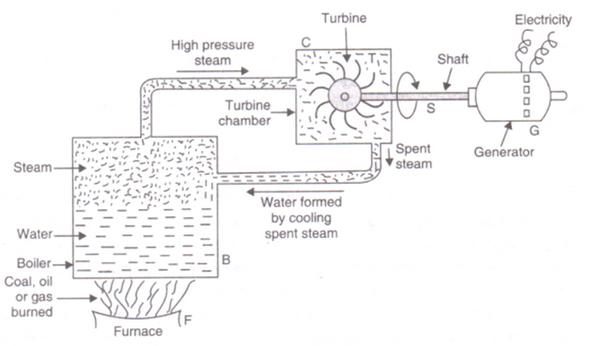
Question 17:
What are the disadvantages of burning fossil fuels ?
Solution :
Disadvantages of burning the fossil fuels are:
(i) The burning of fossil fuels produce acidic gases.
(ii) The burning of fossil fuels produce large amount of CO2 gas, which increases greenhouse effect.
(iii) The burning of fossil fuels produce smoke and leaves behind a lot of ash.
Question 18:
Write a short note on the pollution caused by burning fossil fuels.
Solution :
Burning of fossil fuels leads to the production of many acidic gases like sulphur-dioxide and nitrogen dioxides. These gases causes acid rain which damages trees, plants and buildings, reduces fertility of soil, and poses danger to aquatic life. The burning of fossil fuels puts a poisonous gas carbon monoxide in air. It also produces large amount of CO2 gas which damages the environment in the long run by increasing the greenhouse effect. Also, burning of fossil fuels produces smoke and a lot of ash.
Question 19:
What are the various steps which can be taken to control (or reduce) pollution caused by burning fossil fuels ?
Solution :
Pollution caused by the burning of fossil fuels can be controlled by the increasing the efficiency of combustion process and by using various techniques to reduce the escape of harmful gases and ash into the surrounding air.
Question 20:
If you could use any source of energy for heating your food, which one would you use and why ?
Solution :
We will use LPG due to its high calorific value and smokeless flame.
Question 21:
Why is LPG considered a good fuel ?
Solution :
LPG is considered as good fuel because it has a high calorific value gives a smokeless flame.
Question 22:
Why is LPG considered a better fuel than coal ?
Solution :
LPG is considered as a better fuel than coal because it has a higher calorific value, while burning it does not produce any smoke.
Question 23:
Why is the leakage of LPG detected easily although it is odourless ? State the steps to be taken in case its leakage is detected in the kitchen.
Solution :
For the detection of leakage, a foul smelling substance called ethyl mercaptan is added to the LPG.
In case of LPG leakage in the kitchen, following steps must be taken:
1. The door and windows should be opened at once to allow the gas to escape.
2. The source of gas leakage should be checked and then set right with the help of a gas mechanic.
Question 24:
(a) What are fossil fuels ? Give three examples of fossil fuels.
(b) Describe how fossil fuels were formed.
(c) Explain how, sun is considered to be the ultimate source of fossil fuels.
(d) Which fossil fuels were formed by the buried remains of small plants and animals ?
(e) Which fossil fuel was formed by the buried remains of large land plants ?
Solution :
(a) Natural fuels formed deep under the earth from the pre-historic remains of the organisms (like plants and animals) are called fossil fuels.
Ex. Coal, petroleum and natural gas.
(b) The plants and animals which died millions of years ago and got buried deep in the earth, away from the reach of oxygen, got converted into fossil fuels due to the chemical effects of pressure, heat and bacteria.
(c) Sun is considered to be the ultimate source of fossil fuels because it was the sunlight of long ago that made plants grow and the animals which got buried in the earth also ate plants. So, plants and animals which were originally made by sun’s energy only have been converted into fossil fuels.
(d) Petroleum and natural gas.
(e) Coal.
Lakhmir Singh Physics Class 10 Solutions Page No:132
Question 37:
Fossil fuels are energy rich compounds of an element X which were originally made by the plants with the help of sun’s energy.
(a) Name the element X.
(b) Name another element which is usually found in combination with X in fossil fuels.
Solution :
(a) X = Carbon
(b) Another element which is usually found in combination with carbon in fossil fuels is hydrogen.
Question 38:
The energy in petrol originally came from the sun. Explain how it got into petrol.
Solution :
Petrol is obtained from petroleum, which is a fossil fuel. Fossil fuels were originally made by sun’s energy because it was the sunlight of long ago that made plants and animals grow. So, the energy in petrol originally came from the sun.
Question 39:
A substance X is added to LPG cylinders while filling so as to make the detection of leakage of LPG from the cylinders easy.
(a) Name the substance X.
(b) How does substance X make the detection of leakage of LPG easy ?
Solution :
(a) X is ethyl mercaptan
(b) Ethyl mercaptan has a foul smell that can be detected easily.
Question 40:
The pollution of air caused by burning petroleum fuels (like petrol and diesel) in vehicles can be controlled by fitting a device X in the exhaust system of vehicles.
(a) Name the device X.
(b) How does this device help in controlling air pollution ?
Solution :
(a) Catalytic converter
(b) It converts poisonous carbon monoxide into non-poisonous carbon dioxide and harmful nitrogen oxides into harmless nitrogen gas.
Lakhmir Singh Physics Class 10 Solutions Page No:140
Question 1:
A hydro-power plant converts one form of energy into another. Name the two forms of energy.
Solution :
Potential energy into electrical energy.
Question 2:
What type of energy is possessed by flowing water ?
Solution :
Kinetic energy.
Question 3:
Flowing water can rotate a turbine. Which type of energy is used up by the turbine ?
Solution :
Kinetic energy of water.
Question 4:
Name the original source of wind energy.
Solution :
Sun.
Question 5:
What should be the minimum wind speed for the satisfactory working of a wind-powered electric generator ?
Solution :
15 km/hr.
Question 6:
Write one use of wind energy (a) in the past (b) at present.
Solution :
Use of wind energy
(a) in the past – in flour mills
(b) at present – for generating the electricity through wind-powered generators.
Question 7:
Why is the copper tube of a solar water heater painted black from outside ?
Solution :
Copper tube of solar water heater is painted black because black colour is good absorber of heat.
Question 8:
What type of reactions occurring inside the sun produce solar energy ?
Solution :
Nuclear fusion.
Question 9:
Name some of the solar energy devices.
Solution :
Solar water heater.
Solar cooker.
Solar cell.
Question 10:
What type of reflector is used in a box-type solar cooker ?
Solution :
Plane mirror reflector.
Question 11:
What is the range of temperature which can be achieved in a box-type solar cooker in two to three hours ?
Solution :
About 1000C to 1400C
Question 12:
Name the device which converts sunlight into electricity.
Solution :
Solar cell.
Question 13:
How much solar energy will be received by 1 m2 area in one hour if the solar constant be 1.4 kW/m2 ?
Solution :
Solar constant is 1.4kW/m2 or 1.4 kJ/s/m2.
Solar energy received by 1 m2 area in 1 s = 1.4 kJ
Solar energy received by 1 m2 area in one hour (or 3600 s) = 1.4 x 3600 = 5040 kJ
Question 14:
Fill in the following blanks with suitable words :
A solar cell converts………. energy into…………. energy.
Solution :
sunlight; electrical.
Question 15:
(a) What is the difference between a thermal power plant and a hydro power plant ?
(b) Which of the two causes serious air pollution and how ?
Solution :
(a) Difference between thermal power plant and hydro power plant:
Thermal power plant uses non-renewable sources of energy like coal, oil or gas; whereas hydro power plant uses renewable source of energy i.e. water.
Thermal power plant causes pollution due to the burning of fossil fuels; whereas hydro power plant is environment friendly.
(b) Thermal power plant causes serious air pollution because it emits harmful gases and fly-ash into the air.
Lakhmir Singh Physics Class 10 Solutions Page No:141
Question 16:
Compare the sun and the fossil fuels as the sources of energy.
Solution :
Sun is a renewable source of energy, where as fossil fuels are non-renewable sources of energy.
Question 17:
What kind of mirror, concave, convex or plane, would be best suited for use in a solar cooker ? Why ?
Solution :
Concave and plane mirrors are used for making solar cooker because concave mirror converges a large amount of sun’s rays at a point that is required for high heating and plane mirror reflects the rays of light in the form of a strong beam of sunlight on the top of the box that is required for moderate heating.
Question 18:
(a) Name that part of a box-type solar cooker which allows the sun’s heat rays to enter the box but does not
allow inside heat to go out.
(b) Explain why, a plane mirror reflector is used in a box-type solar cooker.
Solution :
(a) Glass sheet cover
(b) A plane mirror reflector is used in a box type solar cooker so as to get a strong beam of sunlight after reflection from the mirror.
Question 19:
What are the advantages and disadvantages of using a solar cooker ?
Solution :
(a) Advantages of using solar cooker
(i) It saves precious fules like coal, kerosene etc.
(ii) It does not produce any smoke or ash.
(iii) The food cooked in a solar cooker has all its nutrients intact.
(b) Disadvantages of using solar cooker
(i) Solar cooker cannot be used during night time.
(ii) If the day-sky is covered with clouds, it will not be possible to cook the food using solar cooker.
(iii) Direction of reflector has to be changed from time to time to keep it facing the sun.
Question 20:
(a) What is a solar cell ? Draw the labelled diagram of a solar cell.
(b) Name the semi-conductor material which is usually used for making solar cells.
(c) Write the uses of solar cells.
Solution :
(a) Solar cell is a device which converts solar energy directly into electrical energy.
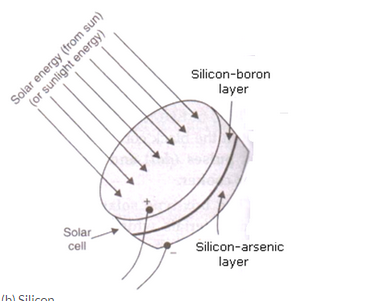
(b) Silicon
(c) Use of solar cell:
i. To provide electricity in artificial satellites and space probes.
ii. To provide electricity to remote areas where normal electricity transmission lines do not exist.
iii. To provide electricity to light houses
iv. To operate traffic signals, watches, calculators and toys.
Question 21:
State the advantages and disadvantages of using solar cells.
Solution :
(a) Advantage of solar cell
(i) They have no moving parts and require no maintenance.
(ii) They can be set up in remote and inaccessible areas
(b) Disadvantage of solar cell
(i) They are very expensive.
(ii) They are less efficient. They can convert only about 25 % of light falling on them into electricity.
(iii) They cannot work during night time.
Question 22:
What is a solar cell panel ? For what purpose is it used ? State its two main advantages.
Solution :
Solar cell panel consists of a large number of solar cells joined together in a definite pattern. It is used to convert solar energy into electricity.
Advantages of solar cell panel are:-
1. It provides much more electric power than a single solar cell.
2. It is used to provide electricity in remote and inaccessible rural areas.
Question 23:
(a) What is solar constant ? What is the value of solar constant ?
(b) If the energy received by 5 m2 area in 10 minutes is 4200 kj, calculate the value of solar constant.
Solution :
(a) The amount of solar energy received per second by one metre square area of the near earth space (exposed perpendicularly to the sun rays) at an average distance between the sun and the earth, is known as solar constant. Its value is 1.4 kJ/s/m2.
(b) Area, A=5m2; time,t=10 min=600sec; E=4200 kJ.
Solar constant =E/(Axt)
=4200/(5×600)
=1.4 kJ/s/m2
Question 24:
How has the traditional use of energy of flowing water been modified for our convenience ?
Solution :
Traditionally, the energy of flowing water has been used for rotating the water-wheels and for driving water-mills to grind wheat to make flour. The traditional use of energy of flowing water has been modified by improvements in technology and it is now used to generate electricity.
Question 25:
How has the traditional use of wind energy been modified for our convenience ?
Solution :
Traditionally, wind energy was used through windmills to pump water from a well and to grind wheat into flour. But the traditional use has been modified and now it is used for the generation of electricity.
Question 26:
(a) What is hydroelectricity ? Explain the basic principle of generation of hydroelectricity with the help of a
labelled diagram.
(b) State two advantages of producing hydroelectricity.
(c) State two disadvantages of producing hydroelectricity.
Solution :
(a) The electricity generated from hydro power plant is known as hydro electricity.
Water is collected in a reservoir at a height, so the water has potential energy stored in it. When the water flows down through this large height, its potential energy gets converted into kinetic energy. The fast flowing water rotates the turbine which is connected to generator through its shaft. The generator produces electricity.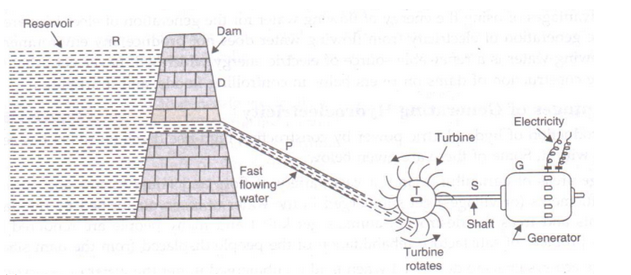
(b) Advantage of producing hydroelectricity:
(i) It does not cause any environmental pollution.
(ii) It uses the energy of flowing water, which is a renewable source of energy
(c) Disadvantage of producing hydroelectricity
(i) Large areas of land are required.
(ii) Large eco-systems get destroyed.
Question 27:
(a) With the help of a labelled diagram, explain the construction and working of a solar cooker.
(b) Why is the solar cooker box painted black from inside ?
(c) Why is the solar cooker box covered with a glass sheet ?
Solution :
(a) Construction and working of solar cooker
A solar cooker consists of an insulated metal box or wooden box which is painted all black from inside. There is a thick glass sheet cover over the box and a plane mirror reflector is also attached to the box.
The food to be cooked is put in metal containers which are painted black from outside. These metal containers are then placed inside the solar cooker box covered with the glass
sheet. The sun’s rays fall on the reflector, get reflected into the box through the upper glass and get trapped within it.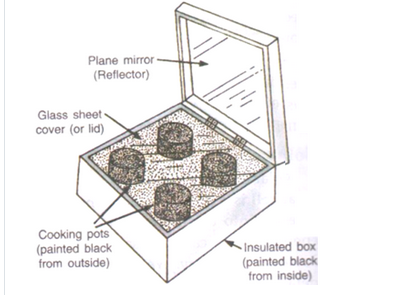
(b) Solar cooker inner body is painted black because black color is a good absorber of heat, so it traps the maximum rays from the sun.
(c) Solar cooker is covered with a glass sheet so as to trap the heat rays in the interior of the box of the cooker.
Question 28:
(a) What is wind ? What type of energy is possessed by wind ?
(b) Explain how, wind energy can be used to generate electricity. Illustrate your answer with the help of a labelled diagram.
(c) State two advantages of using wind energy for generating electricity.
(d) Mention two limitations of wind energy for generating electricity
Solution :
(a) Moving air is known as wind. Wind posses kinetic energy.
(b) The fast moving wind strikes the wind turbine which starts rotating. The shaft of the wind turbine also rotates and drives the generator which produces electricity.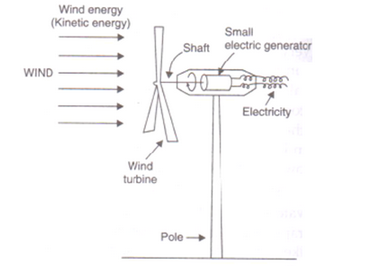
(c) Advantages of using wind energy for generating electricity:
(i) It does not cause any pollution.
(ii) It is available free of cost.
(d) Limitations of wind energy:
(i) Wind energy farms cannot be established everywhere. They can be established only at those places where wind blows for most part of the year.
(ii) Wind energy farms require large area of land for their establishment.
Lakhmir Singh Physics Class 10 Solutions Page No:142
Question 39:
A large coal-fired power station produces 2000 MW of electrical energy. A wind turbine with 33 m blades can produce 300 kW.
(a) How many turbines would be needed to replace the power station ?
(b) Why, in actual practice, this number of turbines could not replace the coal-fired power station ?
Solution :
(a) Electrical energy produced by coal-fired plant = 2000MW = 2000x106W
Electrical energy produced by wind turbine = 300kW = 300x103W
No. of wind turbine required = 2000×106/300×103 = 6666.6
So, 6667 wind turbines would be needed to replace the power station.
(b) In actual practice, this no. of wind turbines could not replace the coal-fired power plant because the efficiency of wind turbines keeps changing due to changes in wind speed but the efficiency of steam turbines used in coal-fired power stations remains the same.
Question 40:
In a solar water heater, why is the storage tank placed at a higher level than the solar panel containing coils ?
Solution :
This is because hot water, being lighter and less denser, rises to the top.
Question 41:
In many applications, solar cells are connected to rechargeable batteries. Why is this so ?
Solution :
The electricity made by the solar cells during day time is stored in rechargeable batteries so that it can be used later on, for example, at night.
Question 42:
(a) Solar cells are used to provide the electric current to charge the batteries of a car driven by an electric
motor. Describe the energy changes which take place.
(b) What differences would you expect in the charging of car batteries (i) in bright sunlight (ii) on a cloudy day (iii) at night ?
Solution :
(a) Solar cells convert solar energy into electrical energy.
While charging the batteries, electrical energy is converted into chemical energy.
During the use of batteries, chemical energy is converted into electrical energy; then electric motor converts electrical energy into kinetic energy (which drives the car).
(b) (i) Batteries are charged quickly.
(ii) Batteries are charged very slowly.
(iii) Batteries are not charged at all.
Lakhmir Singh Physics Class 10 Solutions Page No:148
Question 1:
What substance is obtained as a residue when wood is burned in a limited supply of air ?
Solution :
Charcoal.
Question 2:
Name one source of energy which is not derived from solar energy directly or indirectly.
Solution :
Geothermal energy.
Question 3:
What name is given to the heat energy obtained from hot rocks inside the earth ?
Solution :
Geothermal energy.
Question 4:
Name the agent which decomposes animal dung into biogas.
Solution :
Anaerobic bacteria.
Question 5:
Which component of biogas is used as a fuel ?
Solution :
Methane.
Question 6:
Name the constitutents of biogas.
Solution :
Bio gas consists of methane, carbon dioxide, hydrogen and hydrogen sulphide.
Question 7:
Which of the following is needed for the formation of biogas from cow-dung and which not ?
Water, Oxygen
Solution :
Needed:- water.
Not needed:- oxygen.
Question 8:
Name the clean fuel which can be obtained from cow-dung.
Solution :
Biogas.
Question 9:
Apart from cattle dung, what other substances can be added to a biogas plant ?
Solution :
Apart from cattle dung, human excreta, agriculture wastes, vegetable wastes, poultry droppings, paper scrap etc. can also be added to a biogas plant.
Question 10:
Name any three forms of energy which could be harnessed from the sea.
Solution :
Three forms of energy which could be harnessed from the sea are:
(i) Tidal energy
(ii) Wave energy
(iii) Ocean thermal energy.
Question 11:
Write two forms in which solar energy manifests itself in sea.
Solution :
(i) Sea-waves energy.
(ii) Ocean thermal energy.
Question 12:
Write the full form of OTE.
Solution :
OTE stands for Ocean Thermal Energy.
Question 13:
What is the function of anaerobic micro-organisms such as anaerobic bacteria in a biogas plant ?
Solution :
Anaerobic bacteria help in the degradation of cow-dung in the presence of water but in the absence of oxygen.
Question 14:
State whether the following statement is true or false :
Tidal energy is one of the forms in which solar energy manifests itself in oceans.
Solution :
False
Question 15:
Fill in the following blanks with suitable words :
(a) Biomass is another form in which……… energy manifests itself.
(b) Tidal waves build up and recede……….. a day.
Solution :
(a) solar.
(b) twice.
Question 16:
(a) What is biomass ? Give three examples of biomass.
(b) Name the biomass which is still widely used as a source of heat energy in many households of our country.
Solution :
(a) The dead parts of plants and trees, and the waste material of animals are called biomass. It is the organic matter which is used as a fuel to produce energy. E.g., wood, agricultural wastes and cow dung.
(b) Wood.
Question 17:
What are the two ways in which cow-dung can be used as a fuel ? Which of them is better and why ?
Solution :
Two ways in which cow-dung can be used as a fuel are:
1. In the form of cow-dung cakes, which can be used directly as a fuel.
2. By preparing biogas from cow-dung.
Biogas is better than cow-dung cakes because it gives a cleaner than cow-dung cakes and after extracting biogas, the spent cow-dung can be used as a manure.
Lakhmir Singh Physics Class 10 Solutions Page No:149
Question 18:
How is charcoal prepared ? Explain why, charcoal is a better fuel than wood.
Solution :
Charcoal is prepared by burning wood in a limited supply of air, so that water and other volatile materials present in it get removed.
Charcoal is a better fuel than wood because it has a higher calorific value than wood, and it burns without producing smoke wheras wood produces a lot of smoke on burning.
Question 19:
Compare and contrast biomass and hydroelectricity as sources of energy.
Solution :
(i) Biomass is a renewable source of energy and hydroelectricity is also a renewable source of energy.
(ii) The use of biomass by burning causes air pollution but the use of hydroelectricity does not cause any pollution.
(iii) Biomass gives heat energy which can be used for cooking and heating only. On the other hand, hydroelectricity can run all types of electricical appliances.
(iv) Biomass energy can be obtained without using any special device but hydroelectricity can be produced only by establishing hydro-power plants.
Question 20:
Why is biogas considered an ideal fuel for domestic use ?
Solution :
Biogas is considered an ideal fuel for domestic use because:
(a) Biogas burns without smoke and hence does not cause air pollution.
(b) Biogas has a high calorific value. That is, biogas produces a large amount of heat per unit mass.
(c) Biogas is cheaper than most common fuels.
(d) Biogas is a clean fuel since it burns completely without leaving any residue behind.
Question 21:
(a) Explain how tidal energy can be used to generate electricity.
(b) Why is tidal energy not likely to be a potential source of energy ?
Solution :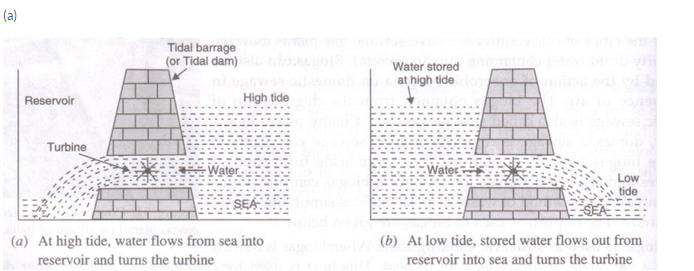
During high tide, when the level of water in the sea is high, sea-water flows into the reservoir of the barrage and turns the turbines. The turbines then turn the generator to produce the electricity. And during the low tide, when the level of sea-water is low, the sea-water stored in the barrage reservoir is allowed to flow out into the sea. This flowing water also turns the turbines and generates electricity.
(b) Tidal energy is not likely to be a potential source of energy because there are very few sites around the world which are suitable for building tidal barrages, and the rise and fall of sea-water during high and low tides is not enough to generate electricity on a large scale.
Question 22:
State two ways in which the energy of sea-waves can be harnessed.
Solution :
Sea-waves energy can be harnessed by by the following ways:
1. By setting up floating generators in the sea which would move up and down with the sea-waves and their movement would drive the generators to produce electricity.
2. By letting the sea-waves move up and down inside large tubes so that when the waves move up, the air in the tubes is compressed and this compressed air can then be used to turn a turbine of a generator to produce electricity.
Question 23:
What is meant by ocean thermal energy ? Explain how ocean thermal energy can be used to generate electricity.
Solution :
The energy available due to the difference in the temperature of water at the upper surface and the deeper layers of ocean is known as ocean thermal energy.
Ocean thermal energy is used to generate electricity in an Ocean Thermal Energy Conversion power plant (OTEC power plant). A temperature difference of 20oC or more between the surface water and deeper water is needed for the operation of these plants. The warm surface water of ocean is used to boil a liquid like ammonia or chlorofluorocarbon. The high pressure of liquid vapours is used to turn the turbine of a generator and produce electricity.
Question 24:
What are the limitations of energy that can be harnessed from the sea ?
Solution :
Limitations of energy that can be harnessed from the sea:
1. There are very few sites around the world which are suitable for building tidal barrage for harnessing tidal energy. Moreover, the rise and fall of sea-water during high and low tides is not enough to generate electricity on a large scale.
2. The harnessing of sea-waves energy is a viable proposition only at those places where sea-waves are very strong.
3. Though the energy potential from the sea is very large but its large scale exploitation is difficult at the moment.
Question 25:
Suggest a safe and efficient method for the disposal of biowastes and sewage materials. How is this method advantageous to us ?
Solution :
A safe and efficient method for the disposal of biowastes and sewage materials is to utilise them for producing biogas. This method is advantageous to us for getting energy and manure without polluting the environment.
Question 26:
Which of the following sources of energy are not derived from the sun ?
Biomass, Wind, Ocean thermal energy, Geothermal energy, Nuclear fuels, Hydroelectricity, Wave energy, Coal, Petroleum, Tidal energy
Solution :
Following sources of energy are not derived from the sun:
Geothermal energy, nuclear fuels, tidal energy.
Question 27:
(a) What is biogas ? Name the major component of biogas.
(b) What are the raw materials used for making biogas ?
(c) Describe the construction and working of a biogas plant with the help of a labelled diagram.
(d) Write any two uses of biogas.
(e) Write any two advantages of using biogas.
Solution :
(a) Biogas is a mixture of gases produced by anaerobic degradation of biomass in the presence of water but in the absence of oxygen. Methane is the major component of biogas.
(b) Cow-dung and water.
(c) Construction and working of biogas plant: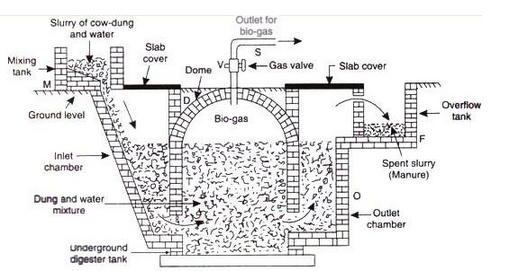
A biogas plant consists of a wall-shaped, underground tank called digester, which is made of bricks, and has a dome shaped roof D. The dome acts as a gas-holder. There is a gas outlet S at the top of the dome having a valve V. There is a sloping inlet chamber I connected to a mixing tank M and a rectangular outlet chamber O connected to the overflow tank F.
Cow dung and water are mixed in equal proportions in the mixing tank M to prepare the slurry. This slurry is fed into the digester tank through the inlet chamber I to fill the tank upto the cylindrical level. Then, the cow-dung undergoes anaerobic degradation with the evolution of biogas which collects in the dome. The pressure of biogas on the slurry forces the spent slurry to go into the overflow tank F through outlet chamber O, from where it is removed.
(d) Two uses of bio gas:
(i) For cooking purpose
(ii) For lightning purpose
(e) Two advantages of biogas:
(i) Smoke-free cooking
(ii) High calorific value
Question 28:
(a) What is geothermal energy ?
(b) What is the source of heat contained in geothermal energy ?
(c) Explain how, geothermal energy is used to generate electricity.
(d) State two advantages of geothermal energy.
(e) State two disadvantages of geothermal energy.
Solution :
(a) Geothermal energy is the heat energy from hot rocks present inside the earth.
(b) Hot rocks present inside the earth are the source of heat contained in geothermal energy.
(c) Extremely hot rocks present below the surface of earth heat the underground water and turn it into steam. As more and more steam is formed between the rocks, it gets compressed to high pressures. This high pressure steam is brought up through pipes and is used to run the turbine of a generator to produce electricity.
(d) Advantage of geothermal energy:
(i) It is very economical to use.
(ii) It does not cause any pollution.
(e) Disadvantage of geo thermal energy:-
(i) It is not available everywhere.
(ii) Deep drilling in the earth is required, which is technically very difficult and expensive.
Lakhmir Singh Physics Class 10 Solutions Page No:150
Question 42:
A certain form of energy is available due to the difference in the temperature of water at the surface of the ocean and its deeper levels.
(a) Name the form of energy.
(b) Is this energy ultimately derived from the sun or not ?
(c) Explain how this form of energy can be converted into electricity.
(d) What is the minimum temperature difference in water at the surface of ocean and its deeper level which is required to operate power plants based on this energy ?
Solution :
(a) Ocean thermal energy
(b) No
(c) Ocean thermal energy is used to generate electricity in an Ocean Thermal Energy Conversion power plant (OTEC power plant). A temperature difference of 20oC or more between the surface water and deeper water is needed for the operation of these plants. The warm surface water of ocean is used to boil a liquid like ammonia or chlorofluorocarbon. The high pressure of liquid vapours is used to turn the turbine of a generator and produce electricity.
(d) 200C
Question 43:
(a) The gravitational pull of the moon causes the sea-water to rise periodically.
(b) What name is given to the condition of the sea when its water is raised ?
(c) What name is given to the condition of the sea when its raised water recedes ?
(d) What name is given to the energy which can be harnessed from this natural phenomenon ?
(e) Draw labelled diagram to show how this energy can be harnessed to generate electricity.
Solution :
(a) High tide
(b) Low tide
(c) Tidal energy
(d)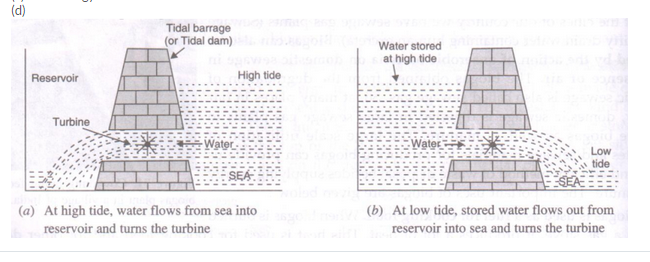
Question 44:
When the material A mined from the earth is heated strongly in an insufficeint supply of air, it produces a solid fuel B which consists mainly of carbon. When another material C obtained from trees is heated in an insufficient supply of air, it produces another solid fuel D which also consists mainly of carbon. Name A, B, C and D.
Solution :
A is coal; B is coke; C is wood; D is charcoal
Question 45:
A certain form of energy which is not sourced directly or indirectly from the sun and does not cause any pollution is very easily converted into electricity. This form of energy is, however, not available everywhere. Moreover, it is technically very difficult and expensive to obtain it. Name the form of energy.
Solution :
Geothermal energy.
Lakhmir Singh Physics Class 10 Solutions Page No:156
Question 1:
What type of nuclear reaction is responsible for the liberation of energy :
(a) in a nuclear reactor ?
(b) in the sun ?
Solution :
(a) Nuclear fission
(b) Nuclear fusion
Question 2:
Which product of the nuclear fission of uranium-235 is utilised to cause further fission of its nuclei ?
Solution :
Neutrons.
Question 3:
Which particles bring about the fission of uranium-235 ?
Solution :
Neutrons.
Question 4:
State whether the fission of uranium-235 is caused by low energy neutrons or high energy neutrons.
Solution :
By the low energy neutrons.
Question 5:
Name the type of nuclear reaction which is involved in the working of:
(a) a hydrogen bomb.
(b) an atom bomb.
Solution :
(a) Nuclear fusion.
(b) Nuclear fission.
Question 6:
Name the moderator used in a nuclear reactor.
Solution :
Graphite.
Question 7:
Of what material are the control rods of a nuclear reactor made ?
Solution :
Boron.
Question 8:
What do you think is the purpose of the thick, concrete chamber surrounding the reactor of a nuclear power plant ?
Solution :
Thick concrete chamber is required to prevent the radioactive rays to travel outside.
Lakhmir Singh Physics Class 10 Solutions Page No:157
Question 9:
Where, in a nuclear power station, is uranium, used up ?
Solution :
Uranium is used up in the reactor.
Question 10:
State one use of nuclear fission reactions.
Solution :
Nuclear fission reactions are used for generating electricity at a nuclear power plant.
Question 11:
Name the unit which is commonly used for expressing the energy released in nuclear reactions.
Solution :
Million electron volt (MeV)
Question 12:
How many MeV are equivalent to 1 atomic mass unit (u) ?
Solution :
1 atomic mass unit=931 MeV
Question 13:
Fill in the following blanks with suitable words :
(a) Splitting of a heavy nucleus into two lighter nuclei is called…………
(b) Uranium-235 atoms will split when hit by……… This is called……………….
(c) Nuclear………. is used in nuclear power stations for the production of electricity.
(d) In a nuclear power station, nuclear fission takes place in the…………
Solution :
(a) nuclear fission
(b) neutrons; nuclear fission
(c) fission
(d) reactor
Question 14:
What is nuclear fission ? Explain with an example. Write the equation of the nuclear reaction involved.
Solution :
The process in which the heavy nucleus of a radioactive atom(such as uranium) splits up into smaller nuclei when bombarded with low energy neutrons, is called nuclear fission.
E.g., When uranium-235 atoms are bombarded with slow moving neutrons, the heavy uranium nucleus breaks up to produce two medium-weighted atoms and 3 neutrons, with the emission of tremendous amount of energy.![]()
Question 15:
(a) What is nuclear fusion ? Explain with an example. Write the equation of the reaction involved.
(b) Why are very high temperatures required for fusion to occur ?
Solution :
(a) The process in which two nuclei of light elements (like that of hydrogen) combine to form a heavy nucleus (like that of helium), is called nuclear fusion.
When deuterium atoms are heated to an extremely high temperature under extremely high pressure, then two deuterium nuclei combine together to form a heavy nucleus of helium, and a neutron is emitted. A tremendous amount of energy is liberated in the process.
(b) Because very high energy is required to force the lighter nuclei (which repel each other) to fuse together to form a bigger nuclei.
Question 16:
What is the nuclear fuel in the sun ? Describe the process by which energy is released in the sun. Write the equation of the nuclear reaction involved.
Solution :
The nuclear fuel in the sun is hydrogen gas.
The sun can be considered as a big thermonuclear furnace where hydrogen atoms continuously get fused into helium atoms. Mass gets lost during these fusion reactions and energy is being produced.
Nuclear reaction:
Question 17:
(a) Write Einstein’s mass-energy equation. Give the meaning of each symbol which occurs in it.
(b) If 25 atomic mass units (u) of a radioactive material are destroyed in a nuclear reaction, how much energy is released in MeV ?
Solution :
(a) Einstein’s equation: E=mc2
where E is the amount of energy produced if mass m is destroyed, and c is the speed of light in vacuum.
(b) 1 atomic mass unit = 931 MeV
25 atomic mass unit = 931 x 25 MeV = 23275 MeV
23275 MeV of energy is released.
Question 18:
(a) What is the source of energy of ths sun and other stars ?
(b) Describe the working of a hydrogen bomb.
(c) What is common between the sun and a hydrogen bomb ?
Solution :
(a) Nuclear fusion reactions 0f hydrogen.
(b) The hydrogen bomb consists of heavy isotopes of hydrogen (deuterium and tritium) alongwith lithium-6. The explosion of hydrogen bomb is done by using an atom bomb. When the aton bomb is exploded, its fission reaction produces a lot of heat which raises the temperature of deuterium and tritium to 107oC in a few microseconds. Then fusion reactions of deuterium and tritium take place producing a tremendous amount of energy. This explodes the hydrogen bomb. Lithium-6 is used to produce more tritium needed for fusion.
(c) The source of energy is same for both the sun and the hydrogen atom, i.e. nuclear fusion.
Question 19:
(a) What will happen if slow moving neutrons are made to strike the atoms of a heavy element 92U235 ? What
is the name of this process ?
(b) Write a nuclear equation to represent the process which takes place.
(c) Name one installation where such a process is utilised.
Solution :
(a) When slow moving neutrons are made to strike the atoms of a heavy element uranium-235, the heavy uranium nucleus breaks up to produce two medium-weighted atoms and 3 neutrons, with the emission of tremendous amount of energy. This process is called nuclear fission.
(c) Nuclear Power Station
Question 20:
(a) What are the advantages of nuclear energy ?
(b) State the disadvantages of nuclear energy.
Solution :
(a) Advantages of nuclear energy:
(i) It produces a large amount of useful energy from a very small amount of a nuclear fuel.
(ii) Once the nuclear fuel is loaded into the reactor, the nuclear power plant can go on producing electricity for two to three years at a stretch. There is no need of feeding the fuel again and again.
(iii) It does not produce gases like CO2 or SO2.
(b) Disadvantages of nuclear energy:
(i) The waste products of nuclear fission reactions are radioactive which keep on emitting harmful radiations for thousands of years and are difficult to store or dispose safely.
(ii) Very high cost of installation is required.
(iii) There is a limited availability of uranium fuel.
Question 21:
The following questions are about the nuclear reactor of a power plant.
(a) Which isotope of uranium produces the energy in the fuel rods ?
(b) Will the fuel rods last for ever ?
(c) Is the energy produced by nuclear fission or nuclear fusion ?
(d) What is the purpose of using the graphite moderator ?
(e) What is the function of boron rods in the nuclear reactor ?
(f) Why is liquid sodium (or carbon dioxide gas) pumped through the reactor ?
Solution :
(a) Uranium-235
(b) No
(c) Nuclear fission
(d) Moderator slows down the speed of neutrons to make them fit for causing fission.
(e) Boron rods are used to absorb excess neutrons and prevent the fission reaction from going out of control.
(f) Liquid sodium or carbon dioxide gas is used as a ‘coolant’ to transfer the heat produced to heat exchanger for converting water into steam.
Question 22:
In the reactor of a nuclear power plant, name the material which is used :
(a) as a moderator
(b) to absorb radiations
(c) in the fuel rods
(d) in the control rods
(e) to carry away heat
Solution :
(a) Graphite
(b) Concrete
(c) Uranium-235
(d) Boron
(e) Liquid sodium
Question 23:
In the nuclear reactor of a power plant:
(a) how do control rods control the rate of fission ?
(b) how is heat removed from the reactor core, and what use is made of this heat ?
Solution :
(a) Control rods control the rate of fission by absorbing the excess neutrons and preventing the fission reaction from going out of control.
(b) Heat is removed from the nuclear reactor core with the help of liquid sodium, which absorbs the heat and transfers it to the heat exhanger. This heat is used for converting water in the heat exchanger into steam, which is then used to produce electricity by rotating a turbine and its shaft connected to a generator.
Question 24:
How does inserting the control rods in the graphite core affect the fission in the reactor ? Explain your answer.
Solution :
On inserting the control rods in the graphite core, the rods start absorbing the excess neutrons and maintain the rate of reaction as per requirement. The rods can be raised or lowered in the reactor from outside. The part which is inside the reactor absorbs neutrons.
Question 25:
What are the advantages and disadvantages of using nuclear fuel for generating electricity ?
Solution :
Advantages of using nuclear fuel: Electricity can be produced for almost two to three years with the same uranium fuel in a nuclear power plant.
Disadvantages of using nuclear fuel: The nuclear wastes produced by the fission of uranium-235 during the generation of electricity are radioactive and extremely harmful.
Question 26:
(a) What is a nuclear reactor ? What is the fuel used in a nuclear reactor ?
(b) With the help of a labelled diagram, describe the working of a nuclear power plant.
(c) How is the working nuclear reactor of a power plant shut down in an emergency ?
(d) Name five places in India where nuclear power plants are located.
Solution :
(a) Nuclear reactor is a device designed to maintain a chain reaction producing a steady flow of neutrons generated by the fission of heavy nuclei. Uranium-235 is used as a fuel in a nuclear reactor.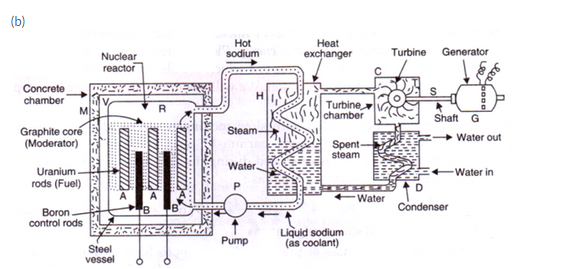
In a nuclear power plant, the fission of uranium-235 is carried out in a reactor R. Uranium-235 rods are inserted in a graphite core which acts as a moderator to slow down the neutrons. Boron rods B absorb excess neutrons and controls the rate of reaction. Liquid sodium or carbon dioxide gas, which is pumped continuously through pipes embedded in reactor by using a pump P, is used as a ‘coolant’ to transfer the heat produced to heat exchanger for converting water into steam. The hot steam at high pressure goes into a turbine chamber and makes the turbine rotate. The shaft of the generator also rotates and drives a generator connected to it.
(c) By inserting the boron control rods fully into the reactor.
(d) Five places in India where nuclear powerplants are located are:
(i) Tarapur.
(ii) Kalpakkam.
(iii) Narora.
(iv) Kaprapur.
(vi) kaiga.
Lakhmir Singh Physics Class 10 Solutions Page No:158
Question 27:
(a) Differentiate between nuclear fission and nuclear fusion.
(b) Which of the two, nuclear fission and nuclear fusion, is made use of :
(i) for the production of electricity ?
(ii) for making a hydrogen bomb ?
(c) Which produces more energy : nuclear fusion or nuclear fission ?
(d) Calculate the energy released in joules when 5 g of a material is completely converted into energy during a nuclear reaction.
(e) How much is this energy in MeV ? (Speed of light = 3 × 108 m/s)
Solution :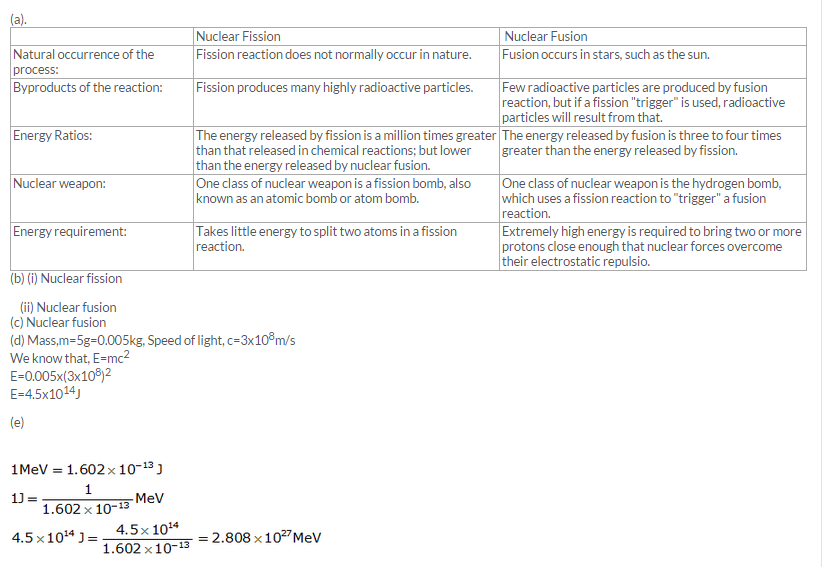
Lakhmir Singh Physics Class 10 Solutions Page No:159
Question 46:
A nuclear reaction is represented by the following equation
(a) Name the process represented by this equation and describe what takes place in this reaction.
(b) Identify the particle c and the number x of such particles produced in the reaction.
(c) What does E represent ?
(d) Name one installation where the above nuclear reaction is utilised.
(e) What type of bomb is based on similar type of reactions ?
Solution :
(a) Nuclear fission; a large nucleus splits into two smaller nuclei with the release of energy, brought about by the absorption of a neutron.
(b) Particles c is neutron; x=3
(c) Energy liberated
(d) Nuclear power station
(e) Atom bomb
Question 47:
A nuclear reaction is represented by the equation![]()
(a) Name the process represented by this equation and describe what happens during this reaction.
(b) Identify the particle c and the number x of such particles produced in the reaction.
(c) What does £ represent ?
(d) State two conditions under which such a reaction takes place.
(e) What type of nuclear bomb is based on similar reactions ?
Solution :
(a) Nuclear fusion; two smaller nuclei combine to form a bigger nucleus with the release of energy, brought about under the conditions of high temperature and pressure.
(b) Particle c is neutron; x=1
(c) Energy liberated
(d) Millions of degree of temperature and millions of pascals of pressure.
(e) Hydrogen bomb.
Question 48:
The mass numbers of four elements A, B, C and D are 2, 20, 135 and 235, respectively. Which one of them will be most suitable to make : (i) an atom bomb, and (it)a hydrogen bomb ?
Solution :
(i) D(mass number 235)
(ii) A(mass number2)
Question 49:
A nuclear power plant is working normally. What would you do if the reactor core suddenly got too hot ?
Solution :
We will insert the control rods of boron a little more into the reactor to reduce the rate of nuclear fission process.
Question 50:
A nuclear reactor has half the length of all its control rods inserted in graphite. What must be done so that the reactor produces more heat ? Explain your answer.
Solution :
The control rods should be withdrawn a little more from inside the reactor. This will increase the rate of nuclear fission process and hence more heat.
Question 51:
Explain why, in a nuclear reactor, the chain reaction stops if the control rods are fully inserted into the graphite.
Solution :
The control rods absorb all the neutrons, stopping the nuclear chain reaction.
Lakhmir Singh Physics Class 10 Solutions Page No:161
Question 1:
Which of the two is a cleaner fuel : hydrogen or CNG ? Why ?
Solution :
Hydrogen is a cleaner fuel because burning of hydrogen produces only water. which is harmless; but burning of CNG produces CO2 and water. CO2 produces greenhouse effect.
Question 2:
Which of the two is more energy efficient: filament type electric bulb or CFL ? Why ?
Solution :
CFL is more energy efficient because it wastes much less energy as heat than filament type electric bulb.
Question 3:
How long are the energy resources of the earth like coal, petroleum and natural gas expected to last ?
Solution :
Coal – 200 years
Petroleum – 40 years
Natural Gas – 60 years
Question 4:
Name two devices which can be utilised for the cooking of food so as to save fuel .
Solution :
Solar cooker; pressure cooker
Question 5:
What are the various factors which we should keep in mind while choosing a source of energy ?
Solution :
Various factors to be kept in mind while choosing a source of energy are:
1. the ease of extracting energy from that source
2. the cost of extracting energy from that source
3. the efficiency of technology available for extracting energy from that source
4. the damage to environment caused by using that source
Question 6:
Can any source of energy be pollution free ? Explain your answer with an example.
Solution :
No. No source of energy is pollution free.
For e.g., the use of wind generators is pollution-free but the processes involved in making it must have damaged the
Question 7:
What are the environmental consequences of the increasing demand for energy ?
Solution :
The environmental consequences of the increasing the demand for energy are:
(i) The combustion of fossil fuels is producing acid rain and damaging plants, soil and aquatic life.
(ii) The combustion of fossil fuels is increasing the green house effect.
(iii) Nuclear power plants are increasing radioactivity in the environment.
(iv) Construction of hydro-power plants is disturbing the ecological balance.
Question 8:
What steps would you suggest to reduce energy consumption ?
Solution :
Steps for reducing the energy consumption:-
(i) Switch off all the lights, fans, TV and other appliances when not needed.
(ii) Use of biogas as cooking fuel should be encouraged.
(iii) Bicycles should be used for short distances to save precious fuels like petrol.
(iv) Solar cookers should be used to cook food.
